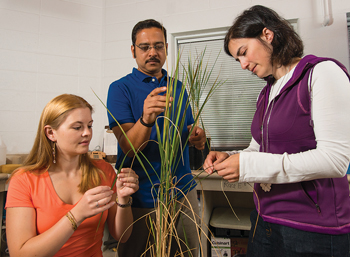Plant scientists fight a cereal killer

RESEARCH | A fungus that kills an estimated 30 percent of the world’s rice crop may finally have met its match, thanks to a research discovery made by scientists at the University of Delaware and the University of California at Davis.
The research team, led by Harsh Bais, associate professor of plant and soil sciences at UD, has identified a naturally occurring microbe that lives right in the soil around rice plants and inhibits the devastating fungus known as rice blast. What’s more, the beneficial soil microbe also induces a system-wide defense response in rice plants to battle the fungus.
The research, which involves gene sequencing, is funded by the National Science Foundation’s Plant Genome Research Project and has been published in BMC Plant Biology. UD authors include Carla Spence, a doctoral student in biological sciences, and Nicole Donofrio, associate professor of plant and soil sciences, as well as Bais and Emily Alff, AG12M.
“We truly are working to disarm a ‘cereal killer’ and to do so using a natural, organic control,” says Bais, in his laboratory at the Delaware Biotechnology Institute. In addition to rice, a distinct population of the rice blast fungus also now threatens wheat production worldwide.
“Rice blast is a relentless killer, a force to be reckoned with, especially as rice is a staple in the daily diet of more than half the world’s population; that’s over 3 billion people,” Bais notes. “As global population continues to grow, biocontrol bacteria may be an important key for farmers to overcome crop losses due to plant disease and to produce more food from the same acre of land.”






